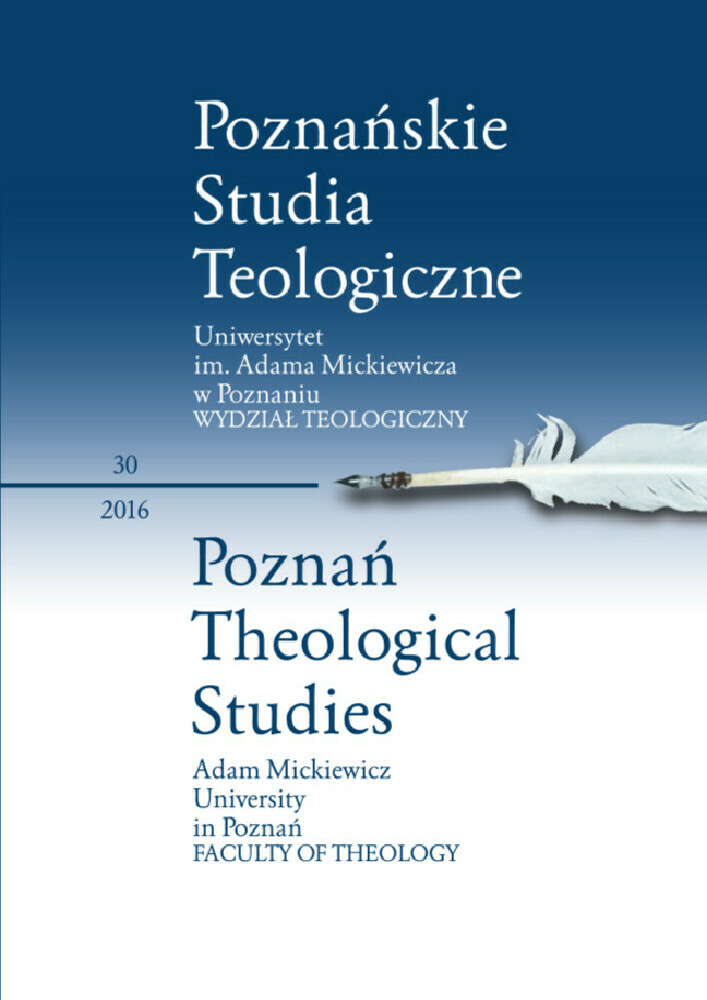Abstract
The article Holiness of the Church according to Sermons of St. Peter Chrysologus presents one aspect of the ecclesiology of the bishop of Ravenna. Among the most popular questions, which are evidenced in his theological reflection, it is necessary to evidence, that Church Fathers focus their attention on an ontological aspect of the Church’s holiness which finds its foundation in Christ. Frequent references to ideas of the Mystical Body of Christ or the Church as a spouse of Christ confirm our opinion. It is necessary to admit that these themes, like other questions, developed in Chrysologus’s sermons (the role of the sacrament or belief that there is no salvation outside the Church) are already known in the patristic literature. Therefore the ecclesiology of the bishop of Ravenna is not original. However, taking into consideration the pastoral dimension of his teaching, it is clear that the objective of his sermons was different than to present an ecclesiological treatise.
The results of analytical researches allow to complete the picture of the doctrine of the Church by its unknown aspect, contained in the teaching of the bishop of Ravenna.
References
Bogacki H., Kościół jako Ciało Mistyczne według św. Hieronima, „Roczniki Teologiczno-Kanoniczne” 5(1958) z. 4, s. 37-53.
Camelot P.T., Die Lehre von der Kirche: Väterzeit bis ausschliesslich Augustinus, Freiburg 1970.
Częsz B., Związek Ducha Świętego z Kościołem w ujęciu świętego Ireneusza i w interpretacji montanistycznej, Poznań 1991.
Drączkowski F., Kościół – agape według Klemensa Aleksandryjskiego, Lublin 1983.
Dublanchy E., L’Église, w: Dictionnaire de Theologie Catholique, t. 4, pars 2, kol. 2108-2152.
Grodecki T., Dlaczego wszyscy muszą być zbawieni? Zbawienie i Kościół u Grzegorza z Nyssy, w: Kościół, świat i zbawienie we wczesnym chrześcijaństwie, red. J. Naumowicz, Warszawa 2004, s. 111-118.
Kaczmarek T., Ecclesia sponsa Christi w nauczaniu św. Cypriana, w: Kościół, świat i zbawienie we wczesnym chrześcijaństwie, red. J. Naumowicz, Warszawa 2004, s. 103-110.
Kasprzak D., Duszpasterze V wieku. Studium porównawcze myśli pasterskiej św. Piotra Chryzologa i Salwiana z Marsylii, Kraków 2008.
Kasprzak D., Kościół IV/V wieku – pomiędzy instytucją Kościoła imperialnego a ideałem Kościoła apostolskiego, w: Kościół starożytny – Królestwo Chrystusa i instytucja, red. F. Drączkowski, Lublin 2010, s. 135-154.
Kelly J.N.D., Początki doktryny chrześcijańskiej, Warszawa 1988.
Kochaniewicz B., La Vergine Maria nei sermoni di san Pietro Crisologo, Roma 1998.
Kołosowski T., Kościół jako wspólnota zbawienia według Hilarego z Poitiers, w: Kościół, świat i zbawienie we wczesnym chrześcijaństwie, red. J. Naumowicz, Warszawa 2004, s. 119-129.
Libera P., Biblijne obrazy Kościoła w pismach św. Ambrożego na przykładzie traktatu „De Isaac et anima”, w: Kościół świat i zbawienie we wczesnym chrześcijaństwie, red. J. Naumowicz, Warszawa 2004, s. 75-85.
Olivar A., La Eucaristía en la predicación de San Pedro Crisólogo, “La Ciencia Tomista” 272(1959), s. 605-628.
Palardy B., The Church and the Synagogue in the Sermons of St. Peter Chrysologus, The Catholic University of America, Washington 1992.
Pałucki J., Trynitarny wymiar Kościoła. Studium patrystyczne, Lublin 2007.
Pałucki J. Eklezjologia Ojców Kościoła, w: Kościół w czasach Jana Pawła II, red. M. Rusecki, K. Kaucha, J. Mastej, Lublin 2005, s. 99-112.
Prus W., Spór o «Ecclesia sancta» w Afryce na podstawie łacińskich przekazów patrystycznych III i IV wieku, Poznań 2013.
Quasten J., Patrology, vol. 2, Notre Dame 1952.
Rahner H., Simboli della Chiesa. L’ecclesiologia dei Padri, Cinisello Balsamo 1995.
Scimè G., Giudei e cristiani nei sermoni di san Pietro Crisologo, Roma 2003.
Staniek E., Kościół – wspólnota czy społeczność. Zarys eklezjologii pierwszych trzech wieków, „Vox Patrum” 10(1986), s. 203-218.
Staniek E., Widzialny aspekt Chrystusowego Kościoła według Ambrozjastra, „Analecta Cracoviensia 10(1978), s. 183-210.
Staniszewski W., Kościół jako Ciało Mistyczne Chrystusa według św. Augustyna, Lublin 1936.
Vogt H.J., Ecclesiologia, w: A. Di Bernardino, Dizionario patristico e di antichità cristiane, vol. 1, Casale Monferrato 1983, koll. 1049-1062.
Wojtczak J., Kościół jako «grex» w Sermones Piotra Chryzologa, w: Kościół, świat i zbawienie we wczesnym chrześcijaństwie, red. J. Naumowicz, Warszawa 2004, s. 154-158.
Ambroży, De institutione virginis. PL 16, koll. 305-334.
Ambroży, Epistula LXXVI. PL 16, koll. 1259-1267.
Augustyn, Epistula CXL, 18. PL 33, koll. 538-577.
Augustyn, Sermo CCXIII. PL 38, koll. 1060-1065.
Bazyli Wielki, Homilia super Psalmum XLIV. PG 29, koll. 388-413.
Cyprian, De catholicae ecclesiae unitate. PL 4, koll. 493-520.
Cyprian, Epistula 73. CCL 3, Turnholti 1994, s. 529-562.
Cyprian, Epistula 75. CCL 3, Turnholti 1994, s. 581-604.
Grzegorz z Nazjanzu, Oratio II. PG 35, koll. 407-513.
Grzegorz z Nyssy, In Christi resurrectionem. Oratio I. PG 46, koll. 600-628.
Ireneusz z Lyonu, Adversus haereses. Liber III. PG 7, koll. 643-972.
Jan Chryzostom, In Epistolam I ad Corinthios, Homilia XXXII. PG 61, koll. 263-276.
Jan Chryzostom, In espistolam ad Ephesios. Homilia XX. PG 62, koll. 135-150.
Klemens z Aleksandrii, Paedagogus. Liber I. PG 8, koll. 249-376.
Optat z Milewy, Traité contre les Donatistes, t. II (livres III a VII). SCh 413, Paris 1996, s. 8-244.
Orygenes, Contra Celsum. PG 11, koll. 641-1652.
Orygenes, Homiliae in librum Jesu nave. Homilia III. PG 12, koll. 856-842.
Orygenes, In Canticum canticorum. PG 13, koll. 61-198.
Orygenes, In Exodum. Homilia IX. PG 12, koll. 361-369.
Piotr Chryzolog, Sermo 60. CCL 24, s. 335-340.
Zenon z Werony, Liber II. Tractatus XXXIII. PL 11, kol. 479.
License
Copyright
© 2016 Uniwersytet im. Adama Mickiewicza w Poznaniu, Wydawnictwo Naukowe UAM, Poznań
OPEN ACCESS
